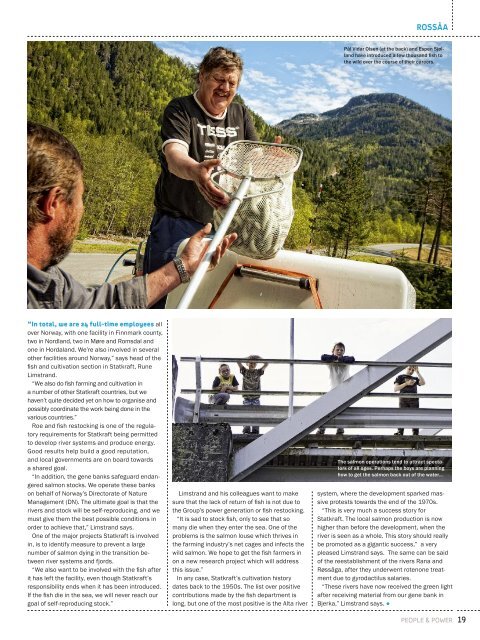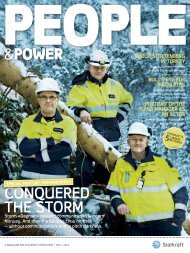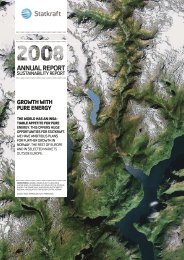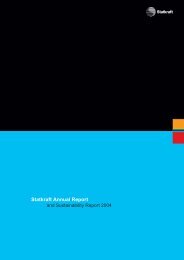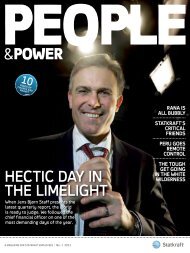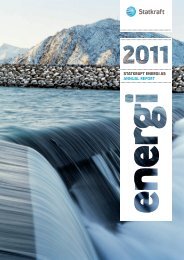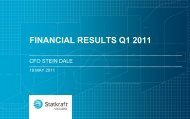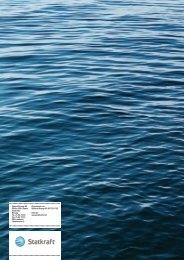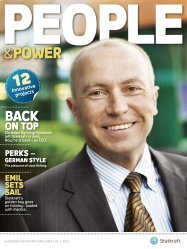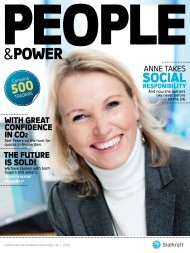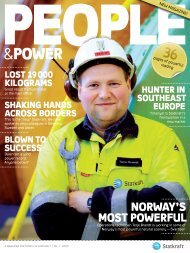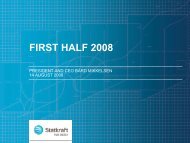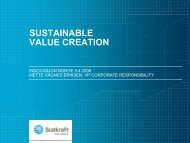No. 3 - 2010 (Download) - Statkraft
No. 3 - 2010 (Download) - Statkraft
No. 3 - 2010 (Download) - Statkraft
You also want an ePaper? Increase the reach of your titles
YUMPU automatically turns print PDFs into web optimized ePapers that Google loves.
“in total, we are 24 full-time employees all<br />
over <strong>No</strong>rway, with one facility in Finnmark county,<br />
twoin<strong>No</strong>rdland,two in Møre andRomsdal and<br />
one in Hordaland. We’re also involved in several<br />
other facilities around <strong>No</strong>rway,” says head of the<br />
fish and cultivation section in <strong>Statkraft</strong>, Rune<br />
Limstrand.<br />
“Wealso do fishfarming andcultivation in<br />
anumber of other <strong>Statkraft</strong>countries,but we<br />
haven’tquite decidedyet on howtoorganise and<br />
possibly coordinate theworkbeing doneinthe<br />
variouscountries.”<br />
Roe and fish restocking isone of the regulatory<br />
requirements for <strong>Statkraft</strong> being permitted<br />
to develop river systems and produce energy.<br />
Good results help build agood reputation,<br />
and local governments are onboard towards<br />
ashared goal.<br />
“In addition, the gene banks safeguard endangered<br />
salmon stocks. We operate these banks<br />
on behalf of <strong>No</strong>rway’s Directorate of Nature<br />
Management (DN). The ultimate goal is that the<br />
rivers and stock will be self-reproducing, and we<br />
must give them the best possible conditions in<br />
order to achieve that,” Limstrand says.<br />
One of the major projects <strong>Statkraft</strong> is involved<br />
in, is to identify measure to prevent a large<br />
number of salmon dying in the transition between<br />
river systems and fjords.<br />
“We also want to be involved with the fish after<br />
it has left the facility, even though <strong>Statkraft</strong>’s<br />
responsibility ends when it has been introduced.<br />
If the fish die in the sea, we will never reach our<br />
goal of self-reproducing stock.”<br />
Limstrand and his colleagues want to make<br />
sure that the lack of return of fish is not due to<br />
the Group’s power generation or fish restocking.<br />
“It is sad to stock fish, only to see that so<br />
many die when they enter the sea. One of the<br />
problems is the salmon louse which thrives in<br />
the farming industry’s net cages and infects the<br />
wild salmon. We hope to get the fish farmers in<br />
on anew research project which will address<br />
this issue.”<br />
In any case, <strong>Statkraft</strong>’s cultivation history<br />
dates back to the 1950s. The list over positive<br />
contributions made by the fish department is<br />
long, but one of the most positive is the Alta river<br />
rossåa<br />
Pål VidarOlsen (atthe back) andEspenSjølland<br />
have introduced afew thousand fishto<br />
thewildoverthe course of theircareers.<br />
The salmon operations tend to attract spectators<br />
of all ages. Perhaps the boys are planning<br />
how to get the salmon back out of the water…<br />
system, where the development sparked massive<br />
protests towards the end of the 1970s.<br />
“This is very much a success story for<br />
<strong>Statkraft</strong>. The local salmon production is now<br />
higher than before the development, when the<br />
river is seen as a whole. This story should really<br />
be promoted as a gigantic success,” a very<br />
pleased Limstrand says. The same can be said<br />
of the reestablishment of the rivers Rana and<br />
Røssåga, after they underwent rotenone treatment<br />
due to gyrodactilus salaries.<br />
“These rivers have now received the green light<br />
after receiving material from our gene bank in<br />
Bjerka,” Limstrand says. ●<br />
people & power 19


